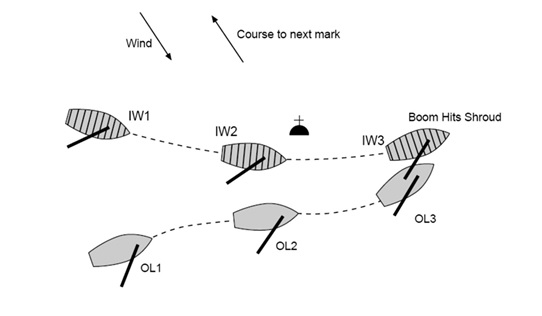



CASE 25
Definitions, Mark-Room
Rule 11, On the Same Tack, Overlapped
Rule 14, Avoiding Contact
Rule 16.1, Changing Course
Rule 18.2(b), Mark-Room: Giving Mark-Room
Rule 43, Exoneration
After an inside overlapped windward boat has been given
mark-room, rule 18 no longer applies, but rule 11 continues
to apply. The inside windward boat must keep clear of the
outside leeward boat, and the leeward boat may luff
provided that she gives the windward boat room to keep
clear.

Facts
Two 15-foot (4.5 m) dinghies, IW and OL, were approaching an offwind
mark that they were required to leave to port. The next leg was a beat to
windward. IW established an inside overlap on OL well before the boats
reached the zone, and OL gave IW space to sail to the mark and to round
the mark onto a close-hauled course. After IW passed the mark, OL began
to luff to her course to the next mark. IW was slower in heading up, and her
boom, still well out, touched OL’s helmsman and shrouds. At the time of
the contact IW was a hull length from the mark and sailing below a closehauled
course. No damage or injury occurred. IW protested OL under rule
18.2(b), and OL protested IW under rule 11.
The protest committee decided that, because IW did not promptly head up
to a close-hauled course after sailing to the mark, she took more space than
she was entitled to under rule 18.2(b). IW did not deny this but attributed it
to her main sheet being led from the end of her boom, as compared to the
centre-boom lead used by OL.
The protest committee dismissed IW’s protest, upheld OL’s, and
disqualified IW for breaking rule 11. IW appealed.
Decision
IW’s proper course was to sail close to the mark, and the course change
necessary to sail the course was to round up to a close-hauled course.
Therefore, rule 18.2(b) required OL to give IW room to sail to the mark and
room to round it onto a close-hauled course, leaving it on the required side
and without touching it. Between positions 1 and 2 OL gave IW room to sail
to the mark and between positions 2 and 3 room to round the mark onto a
close-hauled course. Therefore, OL did not break rule 18.2(b).
The contact, which was the incident that led to the protests, occurred at
position 3. At that time, IW had been given the space she needed to sail to
and around the mark onto a close-hauled course, leaving it on the required
side without touching it. For these reasons, rule 18 did not apply at the time
of the contact (see rule 18.1).
Throughout the incident IW was required by rule 11 to keep clear of OL.
IW sailed a hull length away from the mark on a course below close-hauled,
and shortly before the contact at position 3, IW broke rule 11 by failing to
keep clear.
When OL luffed between positions 2 and 3, OL was required by rule 16.1
to give IW room to keep clear. OL luffed approximately 30 degrees while
moving forward two hull lengths. Even with a boom-end mainsheet rig, a
boat sailed in a seamanlike way can turn through 30 degrees and trim her
mainsail appropriately while moving forward two hull lengths. Therefore,
OL gave IW room to keep clear and did not break rule 16.1.
IW was not exonerated by rule 43.1(b) for breaking rule 11 because, when
she did so, she was sailing to leeward of, not within, the room to which she
was entitled under rule 16.1.
OL could have avoided contact with IW, and so OL broke rule 14. However,
she was exonerated for doing so by rule 43.1(c) because she was the right
of way boat and the contact did not result in damage or injury.
It was possible for IW to have avoided the contact, and therefore IW also
broke rule 14. However, because IW was not sailing within the room to
which she was entitled under rule 16.1, she was not exonerated by rule
43.1(c).
IW’s appeal is dismissed. IW is disqualified under rules 11 and 14.
CAN 1971/9






